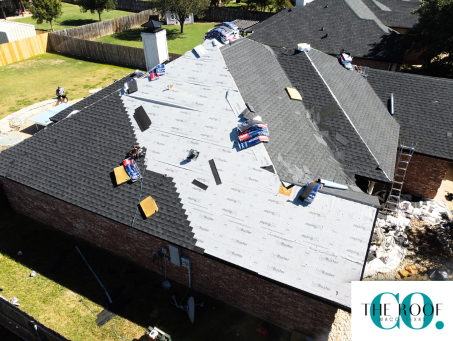
When it comes to protecting your home, a sturdy roof is your primary defense against nature’s elements. Residential roof installation is a significant investment, but it’s also an essential one, ensuring your property’s safety, enhancing its curb appeal, and contributing to long-term energy efficiency. Whether you’re replacing an outdated roof or building a new home, understanding the roof installation process is critical for making informed decisions.
This comprehensive guide will walk you through everything homeowners need to know about residential roof installation, including choosing the best materials, estimating costs, understanding timelines, and ensuring your roof is built to last.
1. What Is Residential Roof Installation?
Residential roof installation involves more than simply putting shingles on a home. It’s a methodical process that requires proper planning, precision, and expertise to create a durable, weather-resistant, and visually appealing roof.
The installation process generally includes:
- Selecting suitable roofing materials
- Preparing the roof deck
- Installing the roofing system, including underlayment and flashing
- Inspecting the completed roof to ensure quality and safety
Whether you’re addressing a roof in disrepair or installing a brand-new system, every step is vital to a successful and long-lasting installation.
Step 1: Assessing Your Roofing Needs
Before starting the roof installation process, it’s essential to evaluate your specific needs. This evaluation helps ensure that your choices align with your home’s requirements and your budget.
1. Age and Condition of Your Current Roof
If you’re replacing your roof, the condition of the current structure will influence the project scope. A roof that’s beyond repair will require a complete tear-off and possibly repairs to the underlying roof deck.
2. Your Budget
Roof installation costs vary widely depending on the materials you choose and the labor involved. Setting a budget early can help you focus on options that fit your financial plan.
3. Your Home’s Style
Your roof plays a significant role in your home’s overall appearance. Whether you prefer a traditional look with asphalt shingles or a modern aesthetic with standing seam metal, your choice should complement your home’s architectural style.
4. Environmental Factors
The climate and weather conditions in your area impact the types of materials and designs that will work best. For example:
- Homes in hot climates may benefit from reflective metal roofing to reduce heat absorption
- Areas with heavy snow may require materials that can handle significant weight
Step 2: Exploring Roofing Material Options
One of the most critical decisions in a residential roof installation is choosing the right materials. Each material comes with its own set of advantages, costs, and lifespans. Here’s an in-depth look at the most popular options:
1. Asphalt Shingles
Asphalt shingles are the most common choice for residential roofs due to their affordability and versatility.
- Cost: $5,000–$10,000 for an average-sized home
- Lifespan: 15–30 years
- Best For: Budget-conscious homeowners and moderate climates
2. Metal Roofing
Metal roofs are gaining popularity for their durability, energy efficiency, and contemporary appearance.
- Cost: $10,000–$25,000 depending on the type (steel, aluminum, copper)
- Lifespan: 40–70 years
- Best For: Areas with heavy rainfall or snow
3. Clay and Concrete Tiles
These materials are ideal for homeowners seeking long-lasting, eco-friendly options that offer unique aesthetics.
- Cost: $15,000–$50,000
- Lifespan: 50+ years
- Best For: Hot climates and Mediterranean-style homes
4. Slate Roofing
Known for its luxury appeal and unparalleled durability, slate roofing is an investment in both beauty and longevity.
- Cost: $20,000–$75,000
- Lifespan: 75–100 years
- Best For: High-end homes and historic restorations
5. Wood Shakes and Shingles
For a natural, rustic look, wood is an excellent choice. However, it requires regular maintenance to prevent issues like rot and insect damage.
- Cost: $10,000–$20,000
- Lifespan: 20–40 years
- Best For: Homes in dry climates or those with eco-conscious designs
Step 3: The Roof Installation Process
Understanding the steps involved in a roof installation can help you prepare for the process and minimize surprises. Here’s a closer look at what happens during a typical residential roof installation:
1. Pre-Installation Inspection and Planning
Before any work begins, a roofing contractor will:
- Conduct a thorough inspection of the existing roof (if applicable)
- Assess the roof deck for structural integrity
- Discuss your goals and provide an estimate of costs and timelines
2. Removing the Old Roof
For replacement projects, the old roof must be removed. This involves tearing off shingles and underlayment and exposing the roof deck for inspection and necessary repairs.
3. Preparing the Roof Deck
A strong foundation is essential for a durable roof. Contractors will repair any damage to the roof deck and reinforce it if needed to ensure a stable base.
4. Installing Underlayment
Underlayment acts as a secondary barrier against water infiltration. Popular choices include synthetic underlayment or felt paper, each providing varying levels of protection.
5. Adding Flashing
Flashing is installed around vulnerable areas like chimneys, vents, and valleys. It directs water away from these critical points, reducing the risk of leaks.
6. Installing Roofing Materials
The roofing materials you’ve chosen are laid down according to the manufacturer’s specifications and industry best practices. Proper installation ensures both functionality and aesthetics.
7. Cleanup and Inspection
Once installation is complete, the contractor will clean up the site, removing debris and ensuring your property is safe. A final inspection guarantees the roof meets quality standards.
Step 4: Costs of Residential Roof Installation
Residential roof installation costs can vary widely based on factors such as materials, labor, and the complexity of the project. Here’s a general breakdown to help you estimate:
Material Costs
- Asphalt Shingles – $2–$5 per square foot
- Metal Roofing – $5–$12 per square foot
- Slate Roofing – $10–$20 per square foot
Labor Costs
Labor typically accounts for 40–60% of the total cost. Complex roofs with steep slopes or intricate designs will incur higher labor expenses.
Additional Costs
- Permits – $100–$1,000 depending on your location
- Structural Repairs – $1,000–$5,000 if the roof deck requires reinforcement
- Tear-Off Fees – $1–$5 per square foot for removing old roofing
Step 5: Timelines for Roof Installation
The timeline for a residential roof installation depends on several factors, including the size of your home, the complexity of the roof design, and weather conditions. Here’s a general estimate:
- Small Homes – 1–2 days
- Medium Homes – 2–5 days
- Large or Complex Homes – 5–10 days
Unexpected delays, such as rain or unforeseen structural issues, may extend the timeline.
Step 6: Hiring the Right Contractor
Choosing the right contractor is crucial for a successful residential roof installation. Here are some tips:
1. Verify Credentials
Ensure the contractor is licensed, insured, and certified to install your chosen materials. Check with local authorities or professional organizations for verification.
2. Review Their Portfolio
Ask for examples of previous work to gauge the contractor’s experience and expertise.
3. Read Reviews and Testimonials
Online reviews and word-of-mouth recommendations can provide insights into a contractor’s reliability and workmanship.
4. Compare Quotes
Request detailed estimates from multiple contractors to find the best balance of cost and quality.
Step 7: Maintaining Your New Roof
A properly installed roof is only as good as its maintenance. Regular care can extend its lifespan and help you avoid costly repairs. Here are some tips:
- Inspect Your Roof Regularly. Look for signs of wear, such as missing shingles or sagging areas.
- Clean Gutters and Downspouts. Prevent water buildup that can lead to leaks.
- Address Issues Quickly. Small problems like minor leaks can escalate if ignored.
- Trim Nearby Trees. Overhanging branches can damage your roof during storms.
Why Residential Roof Installation Is Worth the Investment
Investing in a high-quality residential roof installation offers multiple benefits:
- Increased Property Value. A new roof enhances curb appeal and resale value.
- Energy Efficiency. Modern materials can improve insulation, reducing energy costs.
- Peace of Mind. A durable roof protects your home and family for decades.
To Sum up
A well-executed residential roof installation is more than just a home improvement project—it’s an investment in the safety, longevity, and value of your property. The roof is your home’s shield against the elements, protecting your family and belongings from rain, snow, wind, and sun. Beyond its functional role, your roof also contributes to your home’s curb appeal and energy efficiency, making it a crucial part of your property’s overall performance.
Choosing the right materials, understanding the installation process, and partnering with an experienced contractor are critical steps to ensure a successful outcome. Whether you opt for cost-effective asphalt shingles, durable metal roofing, or the timeless beauty of slate, selecting a material that fits your budget, climate, and style will set the foundation for a roof that lasts decades.
Additionally, investing in a professional installation can save you from costly repairs down the road. Expert contractors ensure that your roof is built to withstand your area’s specific environmental challenges, from heavy snowfall to high winds. Their attention to detail during critical steps—such as installing underlayment, flashing, and ventilation—guarantees that your roof not only looks great but also functions flawlessly.
At Roof Co, we understand that a new roof is a significant investment, and we’re here to make the process as seamless as possible. From helping you choose the perfect materials to deliver impeccable craftsmanship, we’re committed to providing solutions tailored to your needs. Contact us today to schedule a consultation and take the first step toward a durable, beautiful roof that will protect your home for years to come.
Your home deserves the best, and with Roof Co, that’s exactly what you’ll get/
